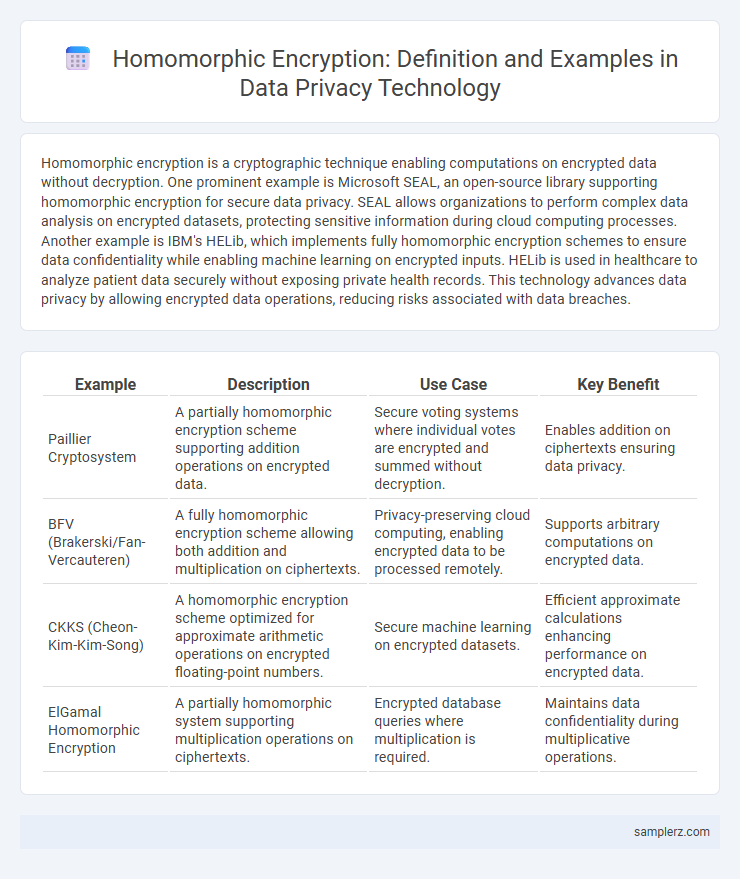Homomorphic encryption is a cryptographic technique enabling computations on encrypted data without decryption. One prominent example is Microsoft SEAL, an open-source library supporting homomorphic encryption for secure data privacy. SEAL allows organizations to perform complex data analysis on encrypted datasets, protecting sensitive information during cloud computing processes. Another example is IBM's HELib, which implements fully homomorphic encryption schemes to ensure data confidentiality while enabling machine learning on encrypted inputs. HELib is used in healthcare to analyze patient data securely without exposing private health records. This technology advances data privacy by allowing encrypted data operations, reducing risks associated with data breaches.
Table of Comparison
| Example | Description | Use Case | Key Benefit |
|---|---|---|---|
| Paillier Cryptosystem | A partially homomorphic encryption scheme supporting addition operations on encrypted data. | Secure voting systems where individual votes are encrypted and summed without decryption. | Enables addition on ciphertexts ensuring data privacy. |
| BFV (Brakerski/Fan-Vercauteren) | A fully homomorphic encryption scheme allowing both addition and multiplication on ciphertexts. | Privacy-preserving cloud computing, enabling encrypted data to be processed remotely. | Supports arbitrary computations on encrypted data. |
| CKKS (Cheon-Kim-Kim-Song) | A homomorphic encryption scheme optimized for approximate arithmetic operations on encrypted floating-point numbers. | Secure machine learning on encrypted datasets. | Efficient approximate calculations enhancing performance on encrypted data. |
| ElGamal Homomorphic Encryption | A partially homomorphic system supporting multiplication operations on ciphertexts. | Encrypted database queries where multiplication is required. | Maintains data confidentiality during multiplicative operations. |
Understanding Homomorphic Encryption in Data Privacy
Homomorphic encryption enables computation on encrypted data without revealing the underlying information, enhancing data privacy by allowing secure analysis in cloud computing and outsourced environments. In healthcare, it permits encrypted patient records to be processed for research without exposing sensitive details, ensuring compliance with data protection regulations like HIPAA. Financial institutions leverage homomorphic encryption to perform risk assessments on encrypted client data, maintaining confidentiality while benefiting from advanced analytics.
Key Applications of Homomorphic Encryption Technology
Homomorphic encryption enables secure data processing by allowing computations on encrypted data without decryption, critical for preserving privacy in cloud computing and outsourced data analysis. Key applications include encrypted search, where users can query databases without exposing sensitive information, and privacy-preserving machine learning, ensuring models can train on encrypted datasets while maintaining confidentiality. Financial institutions leverage homomorphic encryption for secure multiparty computations to jointly analyze encrypted transaction data without revealing individual details.
Real-World Case Studies Utilizing Homomorphic Encryption
Financial institutions leverage homomorphic encryption to perform encrypted data analysis, enabling secure credit scoring without exposing sensitive customer information. In healthcare, homomorphic encryption facilitates privacy-preserving genomic research by allowing computations on encrypted genetic data, maintaining patient confidentiality. Cloud service providers implement homomorphic encryption to offer secure machine learning model training on encrypted datasets, ensuring data privacy in multi-tenant environments.
Homomorphic Encryption in Secure Cloud Computing
Homomorphic encryption enables secure cloud computing by allowing data to remain encrypted while performing computations, ensuring privacy without exposing sensitive information. Companies like IBM and Microsoft leverage this technology to process encrypted data in cloud environments, enhancing data confidentiality and compliance with privacy regulations. This encryption method supports advanced analytics and machine learning on encrypted datasets, reducing the risk of data breaches in multi-tenant cloud infrastructures.
Protecting Healthcare Data with Homomorphic Encryption
Homomorphic encryption enables secure computation on encrypted healthcare data without decrypting it, preserving patient confidentiality during analysis and sharing. Hospitals use this technology to perform remote diagnostics and aggregate clinical data while maintaining compliance with HIPAA regulations. This approach minimizes risks of data breaches and unauthorized access in the healthcare sector.
Enhancing Financial Services Privacy through Homomorphic Encryption
Homomorphic encryption enables financial institutions to perform encrypted transactions and analyze sensitive customer data without decrypting it, thus preserving privacy and minimizing risks of data breaches. This technology allows secure computation on encrypted datasets, facilitating fraud detection and risk assessment while maintaining regulatory compliance. By integrating homomorphic encryption, financial services enhance data confidentiality, bolster trust, and protect against unauthorized access in digital banking environments.
Homomorphic Encryption Use-Cases in Government Data Security
Homomorphic encryption enables governments to securely process sensitive citizen data while maintaining privacy, allowing computations on encrypted datasets without decryption. Use-cases include secure voting systems where ballots remain encrypted throughout tallying, and confidential tax data analysis that prevents exposure of personal financial information. This technology strengthens data security protocols by ensuring that sensitive information remains protected even during complex data processing tasks.
Enabling Private Machine Learning with Homomorphic Encryption
Homomorphic encryption allows machine learning models to process encrypted data without exposing sensitive information, enabling privacy-preserving computations. This technology supports tasks such as training and inference on encrypted datasets, ensuring data confidentiality throughout the machine learning pipeline. Companies like Microsoft and IBM have developed frameworks that leverage homomorphic encryption to enhance secure data analysis in healthcare and finance sectors.
Homomorphic Encryption for Encrypted Database Queries
Homomorphic encryption enables secure database queries on encrypted data without decryption, preserving data privacy in cloud computing environments. This cryptographic technique allows computations such as search, filtering, and aggregation directly on ciphertext, ensuring sensitive information remains confidential throughout processing. Major technology companies and research institutions implement homomorphic encryption to enhance data security in industries like healthcare, finance, and government sectors.
Future Trends of Homomorphic Encryption in Data Privacy
Future trends in homomorphic encryption for data privacy include enhanced performance through optimized algorithms and hardware acceleration, enabling real-time computations on encrypted data. Cloud service providers are increasingly integrating homomorphic encryption to secure sensitive information while maintaining usability in AI and machine learning applications. Research is also focusing on hybrid cryptographic models combining homomorphic encryption with differential privacy to provide stronger, scalable privacy solutions.

example of homomorphic encryption in data privacy Infographic
 samplerz.com
samplerz.com